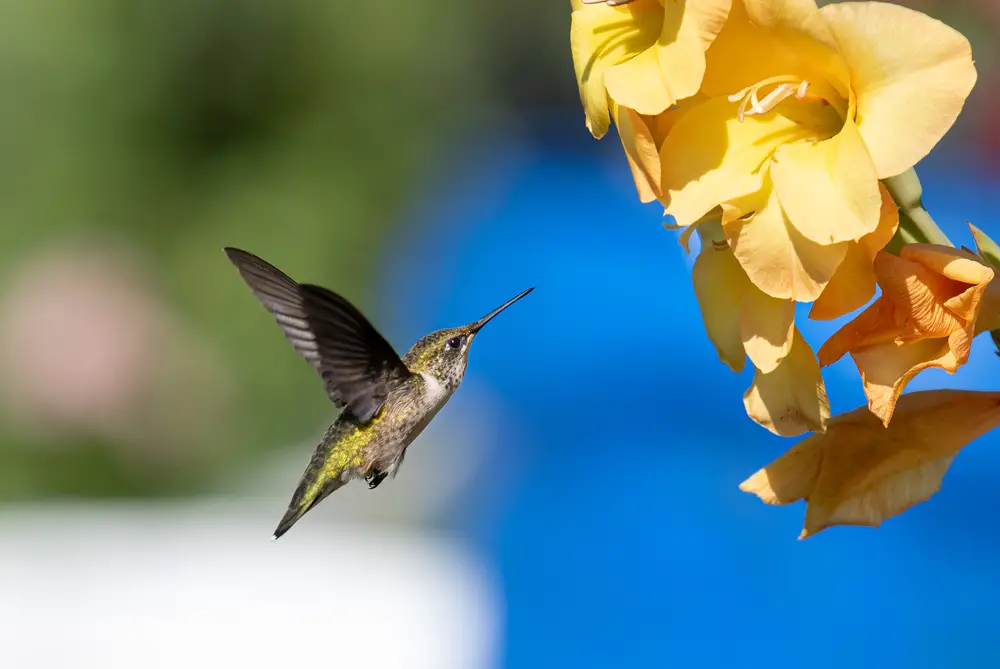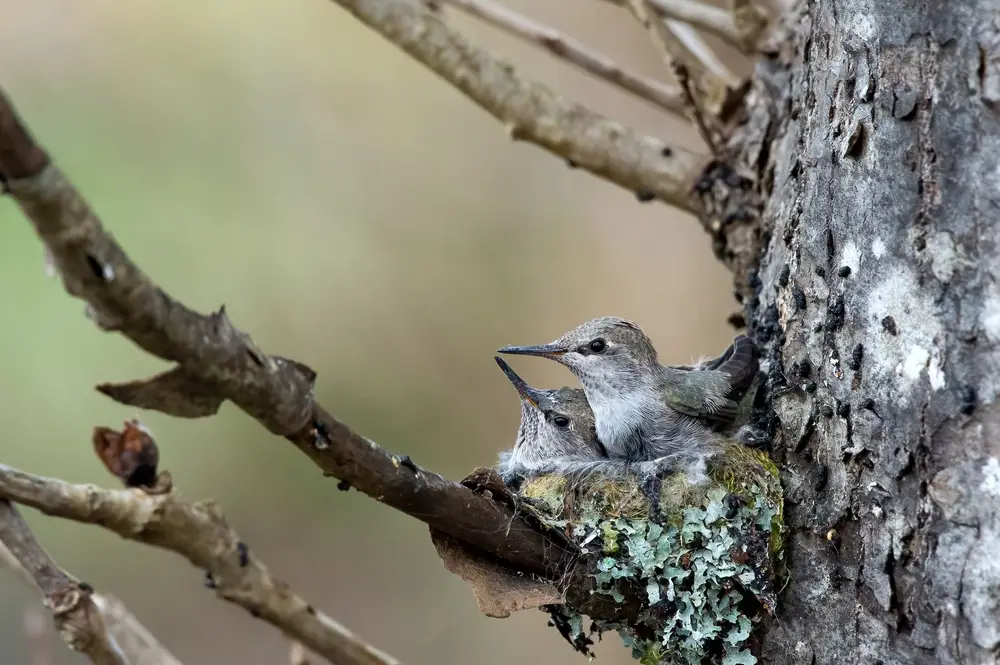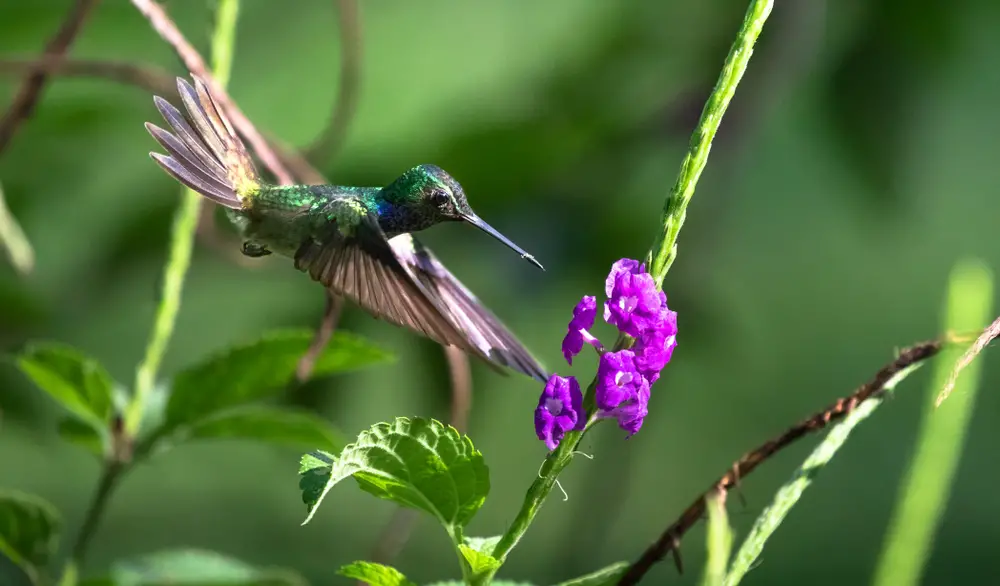Hummingbird reproduction involves a complex process of courtship display, nest building, and care for the babies. Living 1 to 5 years long, most of North America’s hummingbirds will raise 2 broods per season—from eggs the size of a jellybean.
Their mating ritual includes a lovely courtship display that you can observe in your garden. Keep reading to learn more about the lifecycle and mating process.
Table of Contents
Hummingbird Lifecycle
A hummingbird’s lifecycle starts while it’s in the egg. Once they hatch, baby hummingbirds will begin eating with the help of their mother. Most kinds will learn to fly at about 21 days of age.
The mother will still feed them for about three days and show them where the best flowers and feeders are. Hummingbirds will reach sexual maturity at about age 1.
They’ll proceed to mate, and females will work on the nest and lay eggs, while males will move on, looking for another mating partner. During their lives, hummingbirds will act as natural pollinators.
You might see them around nectar feeders and native plants. Some will be defensive of their territory and will fight off other birds. Many hummingbirds will be present during spring and summer and spend winter somewhere else.
How Long Do Hummingbirds Live?
Many hummingbirds die in their first year of life. However, if they survive, their lifespan can drastically increase, and they might reach 5 years of age.
Some of the oldest hummingbirds were a female Broad-tailed Hummingbird that lived for about 12 years and a female Black-chinned Hummingbird that reached about 10 years of age.
Many people believe that these tiny birds die during winter. The truth is, wintering hummingbirds go into torpor—a power-saving state.
This helps them live through the colder months and return to action in the early spring. Migrating birds will move from Canada and the US to warmer areas, such as Mexico and Central America.

Hummingbird Breeding Process
The migrating males will arrive about two weeks before the females establish their breeding grounds. The breeding season differs for each hummingbird species. For example:
- Rufous Hummingbird — April to July
- Allen’s Hummingbird — Arrives at breeding grounds in January
- Costa’s Hummingbird — Varies, but usually occurs from January to May
- Anna’s Hummingbird — December to August
- Ruby-throated Hummingbird (Archilochus colubris) — March to July
What Is the Mating Ritual of a Hummingbird?
If you take some time to be present during hummingbird mating season, you’ll witness the hummingbird courtship display. This is the moment when an adult male will start looping and zigzagging to get the female’s attention.
Many males will fly up to 150 feet in the air and then plummet in front of the female. Courtship display also includes singing, showing off their feathers, and flapping their wings. The flapping is also what creates the recognizable humming sound.
How Long Does the Mating Ritual Last?
After the male hummingbird successfully charms the female, she’ll move to perch on a nearby branch. The male will approach to mount her for about 4 seconds. After the mating is done, each will go their separate way.
Hummingbird Pregnancy
Female hummingbirds are solely responsible for finding the nesting site, making the nest, and laying eggs. Males aren’t involved in any way, as they’ve moved on to find another partner.
Most hummingbird females have already built a nest. Those that didn’t build one will do so about 5 days after mating.
How Long Are Hummingbirds Pregnant?
The incubation period for baby hummingbirds lasts about two weeks. However, the female won’t lay both eggs at the same time. Sometimes, she’ll take a whole day between.
Still, she’ll regulate the temperature in the nest, and both babies will be born simultaneously. They’ll stay in the nest until fledging.

How Many Times Does a Hummingbird Reproduce?
Most hummingbirds will have one to three broods per season. For example, Anna’s hummingbird will have 3 broods annually. Almost all females will lay 1 or 2 eggs, rarely 3.
Hummingbird Eggs and Babies
You’ll rarely get to see hummingbird hatchlings since moms take good care of the nests and babies. The babies will be barely an inch long when they hatch. They’ll have dark skin and closed eyes and will be very fragile for days after birth.
Babies will take up to 5 weeks from eggs to being fully fledged. Most babies will be born in late spring and early summer and will leave their nest in the summertime.
How Do Hummingbirds Build Their Nests?
Once the nesting season starts, females will make nests the size of a walnut. A hummingbird nest is a combination of various plant materials. During her nest-building process, the future mom will use:
- Spider silk
- Spider webs
- Lichens, etc
Hummingbird nests can be found in trees, in sheds, in potted plants, and even on hanging ropes. Nests look like small cups, with edges pointed inwards to protect the eggs. They’re also well camouflaged.
These birds won’t use hollow trees or bird boxes. Furthermore, as nestlings grow, the spider webs help the nest expands. The nest is capable of holding two baby birds and their mom.

What Do Hummingbirds Feed Their Babies?
Since fledglings grow fast, mom will need to use both nectars from hummingbird feeders as well as small insects to support the growth. She’ll regurgitate the food into their beaks every 15 to 20 minutes. Hummingbird moms will also occasionally leave the nest to look for food.
Hummingbird Reproduction Overview
Hummingbirds are miraculous bird species. If they do manage to survive their first year, chances are they’ll live up to 5 years.
Their life cycle starts when they hatch from two eggs the size of jellybeans. Once they’re fully fledged, they’ll leave the nest and mate at about 1 year of age.
Females are responsible for nesting and eggs since males leave and look for a new mating partner. However, the moms are great at it—they’ll make camouflaged nests and take care of the babies all the time.

